One year ago today, darkness engulfed the United States. On March 18, 2020, the final holdout American dioceses suspended public Masses, making it impossible (or at least disobedient) for a lay Catholic in this country to attend Mass.
I followed the shutting down of public Masses closely, creating maps on Twitter so Catholics could see which dioceses had shut down, and which remained opened. Although looking back it seems like the process took a lifetime (March 12-19 last year in general packed a decade’s worth of news into one week), the process was actually quite rapid. On the evening of March 16, 2020, I made my first map:
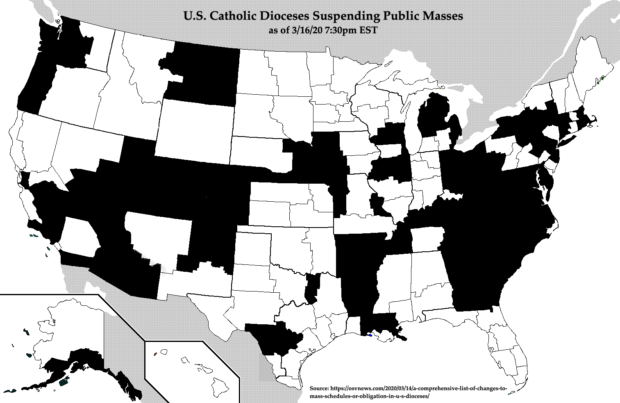
Orthodox. Faithful. Free.
Sign up to get Crisis articles delivered to your inbox daily
My original purpose was to inform Catholics which dioceses were still “open.” I didn’t suspect even then that every diocese would shut down public Masses. I then updated the map twice a day, and it was soon clear what was coming:
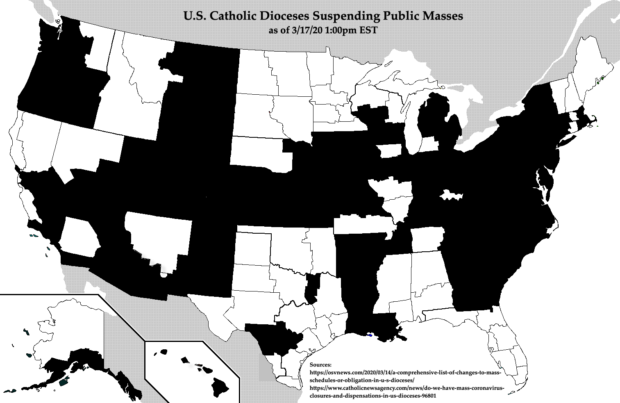
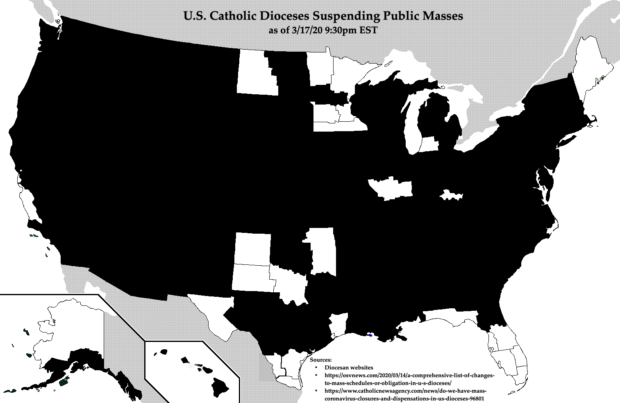
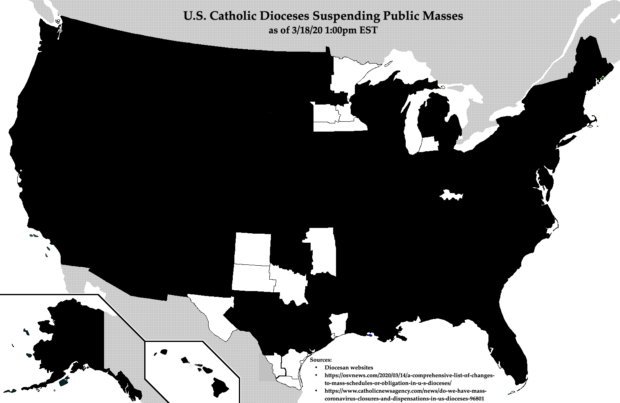
The final, dark map was released the evening of March 18, 2020:
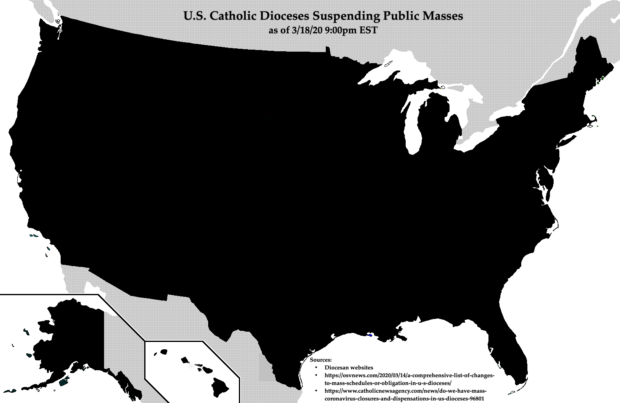
As I said at the time, “Darkness has fallen: every single U.S. diocese has suspended public celebrations of the Mass. For American lay Catholics, it’s now Holy Saturday until further notice.”
The rapidity of the shutdown was breathtaking. When the first bishops cancelled public Masses it was startling, but then every single American bishop—without any exceptions—decided it was best to shut down their parishes. We’re not talking about cancelling the parish book club or even closing the parish school: the bishops made the most important activity any Catholic can participate in completely unavailable to lay Catholics. Even though we all lived through this (and some are still living through variations of it even today), it’s important to take a step back and realize how significant this action was.
It’s also good to remember the craziness of last March. After seeing death tolls mount in other countries, particularly in Italy, panic over COVID-19 became widespread and deep in this country. So little was known that most of us had to rely on “experts” to understand even the first thing about this virus. Most importantly (and most tragically), we had to rely on the now-discredited projections regarding the spread of COVID-19 and its fatality rate. A common figure bandied about was two million dead within months if we didn’t “do something.”
In this unstable environment, it’s understandable, if not quite excusable, that the bishops overreacted. Although at the time many of us thought shutting down public Masses was a terrible precedent, I’m willing to give a general pass on how people reacted last March and April as data was scarce and it really seemed possible that there would be dead bodies on streets across America if action wasn’t taken immediately.
That being said, it’s also clear in hindsight that the bishops folded too quickly and too dramatically. They made two fundamental mistakes: they underestimated the power of the Mass, and they overestimated the power of the State.
The Sacrifice of the Mass has always been the central activity of the Church, and through its graces Catholics are given the strength to grow in holiness. As the Catechism clearly states, the Eucharist is the “source and summit of the Christian life” (CCC 1324). Withholding the Mass from the people is the most extreme measure a bishop can take, and it’s hard to imagine many situations that would demand it. Yet that’s exactly what the bishops did, with little data and a lot of panic behind their decision.
Some might argue that the bishops were forced into these actions by the dictates of the government. After all, many states outlawed any gathering of people, including at religious services. However, the State is not above the Church when it comes to spiritual affairs. The celebration of the Mass is not a freedom granted by the State, but a duty of the Church to celebrate at all times and in all places. Bishops are responsible to God, not the governor.
Further, most states did not make the Mass illegal; it was the Church hierarchy that voluntarily shut it down. In Ohio, for example, the governor’s mandates restricting public gatherings specifically exempted religious services. But the governor met with the Ohio Catholic bishops in a secret meeting, and shortly thereafter those bishops announced the suspension of public Masses. Clearly the governor urged them to comply, even though he knew he had no constitutional authority to do so. And they did, with nary a whimper.
The point of this recap of last year’s insanity is not simply to lay blame at the foot of the bishops. Think of it more as an After Action Report which can hopefully prevent the same mistakes in the future. A few things to consider:
- Every Catholic, from pope to bishop to priest to religious to lay person, must understand the importance of the Mass. This is true at all times, but it is particularly true in times of panic and distress. Nothing is a more “essential service” than the Mass. If Home Depot can stay open, so can St. Helen’s. If we truly believe in the power of the Mass, then we know that its public celebration can quite literally change the world. It’s not unreasonable to wonder if the course of the pandemic and the government response would have been far different if millions of Catholics were at Mass praying for God’s assistance.
- The Church must do all it can to remove illegitimate barriers to receiving Communion. It was terrible when bishops locked the doors to all Catholics, but it’s also terrible when they place unnecessary burdens on people receiving Communion, such as forcing Communion in the hand, or mask-wearing, or even mandating vaccination for Mass attendance.
- The hierarchy must separate itself from its all-too-intimate relationship with the secular State. Yes, Catholics should do what they can to advance the common good, but we shouldn’t be so quick to accept at face value what the State and its “experts” say is the common good. Too many bishops accepted the narrative from government officials that suspending Mass advanced the common good, when exactly the opposite is always true. Suspicion of a secular State should be the default position of all members of the Church, including the hierarchy.
Sadly, it’s undeniable that the American bishops failed in the great test they faced in March 2020. But failure is often the means to future success. We can hope the bishops will look closely at their response to last year’s panic, and when such an event arises again (and it will likely arise repeatedly in the near future), they will respond in a more Catholic and spiritual manner.
Let’s pray that the darkness never falls again.
